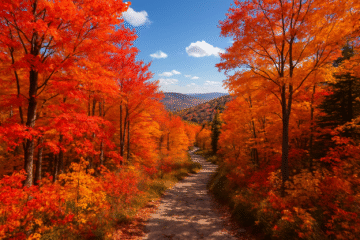I’ll never forget the first time I guided a group of newcomers along the Appalachian Trail. One of them asked me, “What’s the strangest thing you’ve ever had to do out here?” My answer? “Teaching someone how to dig a wilderness bathroom.” It’s moments like these that remind me how preparation can make or break an adventure.
Even after years of experience, I still rely on checklists. Allison, a fellow hiker, once confessed, “I never seem to fail to leave something out without my printed list.” It’s a paradox—balancing the thrill of the unknown with the practicality of being ready for anything.
Whether you’re planning your first trek or just looking to refine your gear, let me walk you through the essentials. From campsite legality to Leave No Trace principles, every detail matters. After all, the trail is as much about the journey as it is about staying prepared.
Key Takeaways
- Preparation is key to a successful backpacking trip.
- Checklists help ensure you don’t forget essential items.
- Understand campsite legality and Leave No Trace principles.
- Balance excitement with practical safety measures.
- Personal responsibility is crucial in the wilderness.
Introduction to Backpacking Essentials
Backpacking changed my life the moment I stepped onto the trails with a mismatched kit. I remember my first trip vividly—I forgot the tent poles during a rainstorm. It was a humbling lesson in preparation and the importance of having the right gear.
Here’s the thing: gear doesn’t need to be perfect for your first trip. Allison, a fellow hiker, has been using her REI Passage 2 Tent since 2015. It’s a great example of balancing cost, weight, and durability. She proves that you don’t need pro-grade equipment to enjoy the trails.

I’ve learned that 20% of your gear prevents 80% of emergencies. This 80/20 rule is a game-changer. Focus on essential systems: shelter, water, and navigation. These are the pillars of a successful trip.
Mike, another hiker I know, swears by high-end gear. While his approach works for him, it’s not necessary for everyone. Allison’s budget-friendly mindset shows that smart choices matter more than price tags. The REI Passage 2 Tent is a perfect case study—it’s affordable, reliable, and lightweight.
Backpacking is about finding what works for you. Whether it’s a budget-friendly tent or a pro-grade sleeping bag, the key is to prioritize the essentials. The trails are waiting, and with the right kit, you’re ready for the adventure.
Why Preparation is Key for Backpacking
Preparation is the backbone of every successful backpacking adventure. It’s not just about packing the right gear—it’s about knowing the rules, understanding the terrain, and anticipating challenges. Mike, a seasoned hiker, once warned me, “Don’t camp illegally—know park-specific dispersed camping rules.” His advice saved me from a hefty fine and a lot of stress.
Did you know that 43% of wilderness emergencies stem from poor planning? It’s a staggering statistic that highlights the importance of being ready. Mike’s “day hike recon” strategy is a game-changer. Before setting up camp, he scouts the area during a day hike to ensure it’s safe and legal. It’s a simple yet effective way to avoid surprises.

Permit systems can be tricky, but they’re essential for protecting the environment. In places like North Cascades and the Enchantments, 60% of permits are reserved in advance, while 40% are available on a walk-up basis. Planning ahead ensures you secure your spot and avoid disappointment.
I learned the hard way about being unprepared during a trip to Olympic National Park. I forgot to bring vault toilet paper—an embarrassing mistake that taught me to double-check my supplies. Now, I rely on Allison’s downloadable checklist as my planning cornerstone. It’s a lifesaver for staying organized and ensuring I don’t miss anything crucial.
Preparation isn’t just about avoiding mistakes—it’s about creating a smoother, more enjoyable experience. Whether it’s understanding permit systems, scouting campsites, or using a checklist, taking the time to plan makes all the difference. For more tips on preparing for your next adventure, check out this comprehensive guide.
Must-Have Gear for Your Backpacking Adventure
There’s something magical about strapping on a backpack and stepping into the unknown. The right gear can transform your experience, ensuring comfort and safety on the trail. Let’s dive into the essentials—backpacks, sleeping systems, and shelters—that will make your journey unforgettable.
Backpacking Backpack
Your backpack is your lifeline. Allison swears by her Deuter 45L for its organizational pockets, while I lean toward the Granite Gear Blaze 60L for its ultralight design. Both are excellent choices, but it’s about finding what fits your needs. Pro tip: That extra pound feels like ten after mile fifteen, so prioritize weight and comfort.

Sleeping Bag and Pad
On a freezing -17°F night, my Big Agnes down sleeping bag paired with the Therm-a-Rest NeoAir XTherm saved me. The pad’s design ensures no body parts touch the ground, keeping you warm and comfortable. Investing in a quality sleeping system is non-negotiable for cold nights.
Tent and Shelter
Shelter is your sanctuary. The REI Passage 2 is affordable and reliable, while the MSR Hubba Hubba excels in storm-worthiness. If you’re hiking with a partner, split the tent components to share the weight. It’s a simple trick that makes a big difference.
Choosing the right gear is about balancing weight, durability, and functionality. Whether it’s a backpack, sleeping system, or shelter, prioritize what keeps you safe and comfortable. The trails are calling—make sure you’re ready.
Stay Safe: Must-Have Items for Your First Backpacking Trip
One of the most important lessons I’ve learned on the trail is that emergencies don’t wait for you to be ready. Whether it’s a sudden storm or a gear malfunction, being prepared can make all the difference. The survival equation is simple: (Shelter + Water + Signaling) x Time = Rescue. It’s a formula that’s saved me more than once.
When it comes to signaling for help, the Garmin inReach Mini is a game-changer. Unlike the SPOT Gen4, it offers two-way messaging and GPS tracking, which can be crucial in remote areas. I’ve relied on it during unexpected detours, and it’s worth every penny.

Allison taught me a brilliant hack for gear repairs: duct tape and trekking poles. When my tent pole snapped during a storm, she showed me how to splint it with a trekking pole and secure it with duct tape. It’s a trick every backpacker should know.
Your first aid kit should include essentials like super glue for sealing wounds, antihistamines for allergic reactions, and blister care supplies. I once forgot to check my headlamp battery before a midnight bathroom run—lesson learned. Now, I always carry spares.
Preparation isn’t just about having the right gear—it’s about knowing how to use it. From signaling devices to quick fixes, these tools can turn a potential disaster into a manageable situation. The wilderness rewards those who are ready.
Navigational Tools for the Trail
Navigating the trail is both an art and a science, blending old-school tools with modern tech. Whether you’re on a rugged backpacking route or a casual hike, having the right system can mean the difference between adventure and disaster. Let’s explore the essentials—maps, compasses, and GPS devices—that will keep you on track.

Maps and Compass
There’s something timeless about a map and compass. Allison and I practice “Triangulation Tuesday” with her Suunto compass—a fun way to sharpen our skills. National Geographic waterproof maps are durable, but CalTopo custom prints offer hyper-local detail. Both are excellent choices for staying oriented.
GPS Devices
When it comes to GPS, the debate between Gaia and Garmin is real. Gaia’s affordability and offline maps are great, but Garmin’s reliability in remote areas is unmatched. I learned this the hard way when my phone GPS led me on a 4-mile detour. Now, I always carry a dedicated device.
Pro Tip: Mark emergency waypoints at water sources and campsites. It’s a simple step that can save you time and stress. Navigation isn’t just about finding your way—it’s about staying prepared for whatever the trail throws at you.
Water and Food Essentials
The first time I ran out of water on a remote trail, I realized how crucial hydration is for survival. Whether you’re on a day hike or a multi-day backpacking adventure, water and food are non-negotiable essentials. Let’s dive into the tools and strategies that will keep you fueled and hydrated on the trail.

Water Filtration Systems
Clean water is your lifeline. I’ve tested dozens of filters, but the Sawyer Squeeze and Katadyn BeFree stand out. Here’s a quick comparison to help you choose:
| Filter | Flow Rate | Maintenance |
|---|---|---|
| Sawyer Squeeze | 1.7 liters/minute | Easy backflushing |
| Katadyn BeFree | 2.0 liters/minute | Frequent cleaning |
I learned the hard way about unfiltered water. A sip from a stream left me with a Giardia nightmare that sidelined me for days. Always filter your water, no matter how clear it looks.
Meal Planning and Snacks
Food is fuel, and planning is key. Allison swears by her baguette and salami combo, but I lean toward Good To-Go dehydrated meals for convenience. Here are some tips:
- Repackage freeze-dried meals to save space.
- DIY pizza wraps are a trail favorite.
- Pack electrolyte tablets for your Nalgene and plain water in your Camelbak.
Remember, water math is simple: 1 liter per 2 hours of hiking, plus 50% extra for dry camps. And don’t forget to balance your meals with protein, carbs, and fats to keep your energy steady.
Safety and Emergency Gear
The wilderness has a way of testing your limits, especially when you least expect it. Whether it’s a sudden storm or an unexpected injury, being prepared can turn a potential disaster into a manageable situation. Safety isn’t just about having the right gear—it’s about knowing how to use it effectively.

Building a Custom First Aid Kit
Your first aid kit is your lifeline in the wild. I learned this the hard way when a minor cut turned into a major inconvenience. Now, I always pack essentials like a tourniquet, chest seals, and an emergency blanket. These items can make all the difference in a crisis.
Mike taught me a brilliant hack: using an emergency poncho or trash bag for insulation. It’s lightweight, versatile, and can save you from hypothermia. Don’t forget to double-wrap toilet paper in ziplocks—it’s not just for hygiene but also works as tinder in emergencies.
Emergency Communication Devices
When you’re miles from civilization, staying connected is crucial. I rely on the Garmin inReach Mini for its two-way messaging and GPS tracking. Here’s a quick comparison of popular devices:
| Device | Features | Best For |
|---|---|---|
| Garmin inReach Mini | Two-way messaging, GPS tracking | Remote areas |
| SPOT Gen4 | One-way messaging, SOS | Basic emergencies |
Always check your device’s battery before heading out. I once forgot, and it left me stranded without a way to call for help. Now, I carry spares and test everything beforehand.
Weatherproofing is another critical aspect. Contractor bags are a budget-friendly alternative to fancy pack covers. They’re durable, lightweight, and keep your gear dry in heavy rain. For more tips on mountain camping safety, check out this comprehensive guide.
Remember, the trail rewards those who are ready. From signaling devices to quick fixes, these tools ensure you’re prepared for whatever the wilderness throws your way.
Clothing and Layering Tips
Layering is an art form in the wilderness, and mastering it can mean the difference between comfort and misery. Allison’s KÜHL layering system is a perfect example of how to stay adaptable in changing conditions. She taught me that the right combination of base, mid, and outer layers can handle anything the trail throws at you.
Material matters. Merino wool is my go-to for its natural breathability and odor resistance, while synthetic fabrics dry quickly and are more affordable. I learned this the hard way during a hypothermia scare—wearing a cotton shirt in cold, wet weather was a huge mistake. Cotton absorbs moisture and loses its insulating properties, making it a poor choice for backpacking.

When it comes to rain gear, the debate between Frogg Toggs and Arc’teryx is ongoing. Frogg Toggs are budget-friendly and lightweight, but Arc’teryx offers unmatched durability and protection. I’ve used both, and while Frogg Toggs are great for occasional showers, Arc’teryx is my choice for extended downpours.
Here’s a pro tip that changed my life: sleep with your next day’s clothes in your sleeping bag. It keeps them warm and dry, so you’re not shivering into cold layers in the morning. And don’t forget the 200-foot bathroom distance rule—always keep your items organized and accessible for quick trips.
Whether you’re facing rain, wind, or sun, your clothing is your first line of defense. Invest in quality gear, layer smartly, and you’ll be ready for whatever the trail brings.
Leave No Trace Principles
The wilderness teaches lessons in ways you’d never expect—like the time I learned about Leave No Trace from an angry marmot. It was a stark reminder that even small actions can have big consequences. Whether you’re on a backpacking trip or a day hike, respecting the trail and the backcountry is essential.
Mike’s “impacted campsite” strategy is a game-changer. He always chooses sites that show minimal human impact, ensuring we don’t contribute to further degradation. Allison, on the other hand, taught me the importance of packing out dirty toilet paper. It’s a small but crucial step in keeping the wilderness pristine.

Beyond the basics, there’s etiquette to consider. Quiet hours are sacred in the backcountry, and blasting music from a speaker is a surefire way to annoy fellow hikers. When it comes to waste, the Deuce of Spades trowel is my go-to for digging proper catholes. It’s lightweight, durable, and makes the process quick and efficient.
Unattended snacks can attract wildlife, as I learned the hard way. A marmot once raided my pack, leaving me with nothing but crumbs. Now, I always store food securely. Fires are another area where Leave No Trace principles apply. Established rings are ideal, but if you’re in a no-trace area, mound methods are a better alternative.
Here’s a quick comparison of fire methods:
| Method | Best For |
|---|---|
| Established Rings | Designated campsites |
| Mound Methods | No-trace areas |
Finally, for backcountry baths, biodegradable Dr. Bronners is a must. It’s eco-friendly and versatile, making it one of the most useful items in my pack. For more detailed guidance on Leave No Trace principles, check out this comprehensive guide.
Practical Tips for First-Time Backpackers
The first time I packed my backpack, I learned that organization is everything. Allison taught me her gear compression strategies, which turned my chaotic mess into a streamlined system. Mike’s “camp away from water sources” rule also saved me from a soggy night and potential wildlife encounters. Here are some tips to make your backpacking experience smoother.
Packing Your Backpack
Packing is an art. Heavy items like your sleeping bag and food should be close to your back for better balance. Rain gear goes on top for quick access during sudden storms. Allison’s compression sacks are a game-changer—they shrink bulky items like jackets and sleeping bags, freeing up space.
I once made the mistake of improper food storage, leading to a “bear canister fiasco.” Now, I always use bear-resistant containers and keep them at least 100 feet from my tent. Here’s a comparison of Allison’s and Mike’s packing strategies:
| Strategy | Pros | Cons |
|---|---|---|
| Allison’s Compression | Saves space, organizes gear | Requires extra sacks |
| Mike’s Heavy Items Close | Improves balance | Can feel bulky |
Pro Tip: Use trekking poles as tent poles in emergencies. It’s a trick that’s saved me more than once.
Setting Up Camp
Camp setup is all about location and orientation. Mike’s rule of camping away from water sources prevents flooding and keeps wildlife at bay. Always position your tent’s windbreak side against the wind and set up your kitchen downwind to avoid smoke.
For night routines, switch your headlamp to red mode. It preserves your night vision and makes stargazing easier. I learned this the hard way after blinding myself with a bright white light.
Whether you’re packing your backpack or setting up camp, these tips will make your trip more enjoyable. The wilderness rewards those who are prepared, so take the time to plan and organize. Happy hiking!
Conclusion
The trail has a way of teaching lessons you didn’t know you needed. My first solo backpacking trip was a turning point—I discovered resilience I never knew I had. Mike’s words echo in my mind: “Get out there, be safe.” It’s a reminder that preparation and adaptability are your greatest allies on the trail.
Allison’s transformational program, “Path to the Wild,” is a fantastic resource for anyone looking to deepen their connection with nature. It’s more than just a guide—it’s a way to unlock your potential. Download her checklist and join our newsletter for more tips and stories.
Your fears will shrink as your skills grow. The wilderness rewards those who respect it. The adventure is out there, waiting for you. As I always say, “The trail provides…if you respect it.”



0 Comments